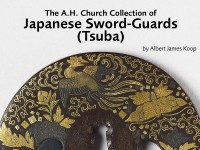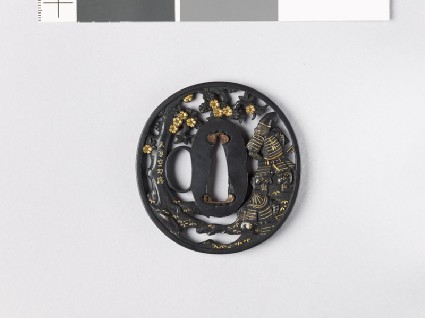The A. H. Church Collection of Japanese Sword-Guards (Tsuba)
An unpublished catalogue of the A. H. Church collection of Japanese sword-guards (tsuba) by Albert James Koop.

Publications online: 1264 objects
Tsuba depicting the Japanese hero Takanori
-
Literature notes
To right the Japanese hero Kojima Takanori (14th century), in full armour, with a kneeling companion; to left the cherry-tree from which he has cut a generous section of bark and has written (in gold inlay) on the bared wood the historic inscription: (on the front) Ten Kōsen wo horobosu nakare (Japanese text), "Heaven, destroy not Kou-chien," and (on the back) toki no Hanrei naki ni shimo ni arazu (Japanese text), "as long as Fan Li is among the living."
When the Emperor Go-Daigo was being carried into exile, Takanori, failing to rescue him on the road, wrote the above quotation at night on a tree outside the inn where the captive was resting. Next morning only the Emperor himself was able to understand the allusion, which was to an ancient King of China, who, after 20 years of warfare, was finally helped to victory by a faithful vassal. -
Details
- Associated place
- Date
- 19th century (1801 - 1900)
- Material and technique
- shakudō, with cut and filed openwork decoration, Hikone-bori carving, iro-e zōgan (multi-metal inlay) decoration, and inlaid with gold; tang-hole plugged with soft metal, probably copper
- Dimensions
- 7 x 6.7 cm (height x width)
- Material index
-
processed material › metal › alloy › copper alloy › shakudō,processed material › metal › gold,
- Technique index
-
cut,
- Object type index
-
arms/armour › koshirae › kodogu › tsuba
- No. of items
- 1
- Credit line
- Bequeathed by Sir Arthur H. Church, 1915.
- Accession no.
- EAX.10789
-
Further reading
Koop, Albert James, The A. H. Church Collection of Japanese Sword-Guards (Tsuba), 3 vols (Oxford, Ashmolean Museum, 1929), no. 789
Glossary (2)
shakudō, tsuba
-
shakudō
alloy of copper and gold, patinated to a dark blue-black colour
-
tsuba
Japanese sword guard.
Location
-
- currently in research collection
Objects are sometimes moved to a different location. Our object location data is usually updated on a monthly basis. Contact the Jameel Study Centre if you are planning to visit the museum to see a particular object on display, or would like to arrange an appointment to see an object in our reserve collections.
Publications online
-

The A. H. Church Collection of Japanese Sword-Guards (Tsuba)
To right the Japanese hero Kojima Takanori (14th century), in full armour, with a kneeling companion; to left the cherry-tree from which he has cut a generous section of bark and has written (in gold inlay) on the bared wood the historic inscription: (on the front) Ten Kōsen wo horobosu nakare (Japanese text), "Heaven, destroy not Kou-chien," and (on the back) toki no Hanrei naki ni shimo ni arazu (Japanese text), "as long as Fan Li is among the living."
When the Emperor Go-Daigo was being carried into exile, Takanori, failing to rescue him on the road, wrote the above quotation at night on a tree outside the inn where the captive was resting. Next morning only the Emperor himself was able to understand the allusion, which was to an ancient King of China, who, after 20 years of warfare, was finally helped to victory by a faithful vassal.
Notice
Object information may not accurately reflect the actual contents of the original publication, since our online objects contain current information held in our collections database. Click on 'buy this publication' to purchase printed versions of our online publications, where available, or contact the Jameel Study Centre to arrange access to books on our collections that are now out of print.
© 2013 University of Oxford - Ashmolean Museum

